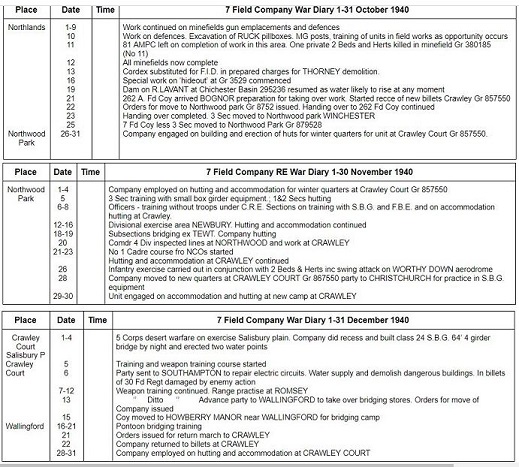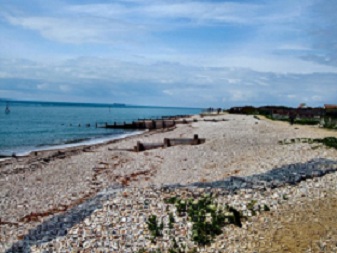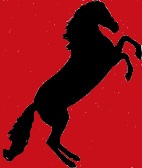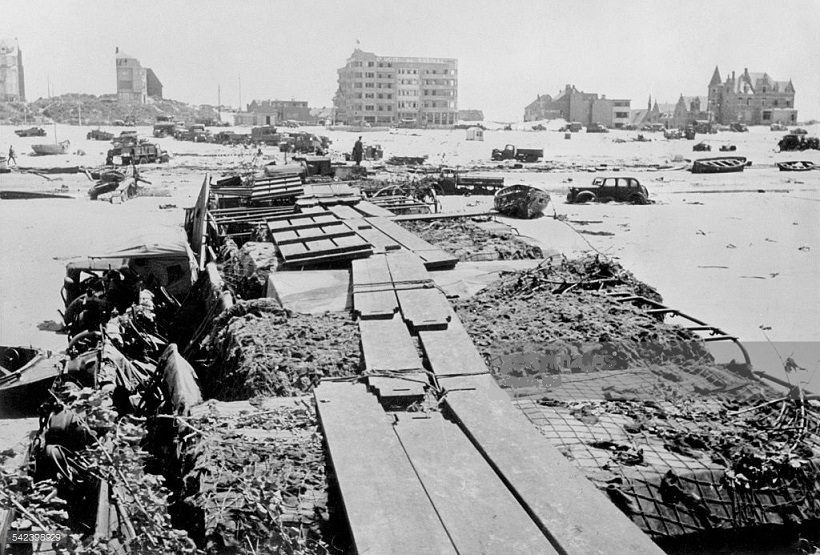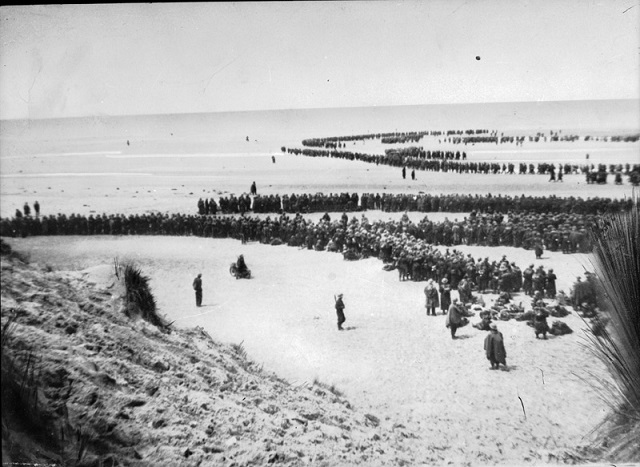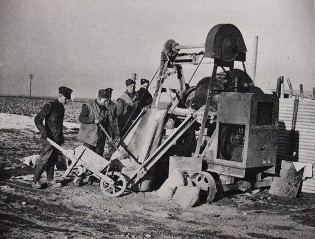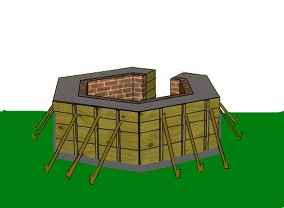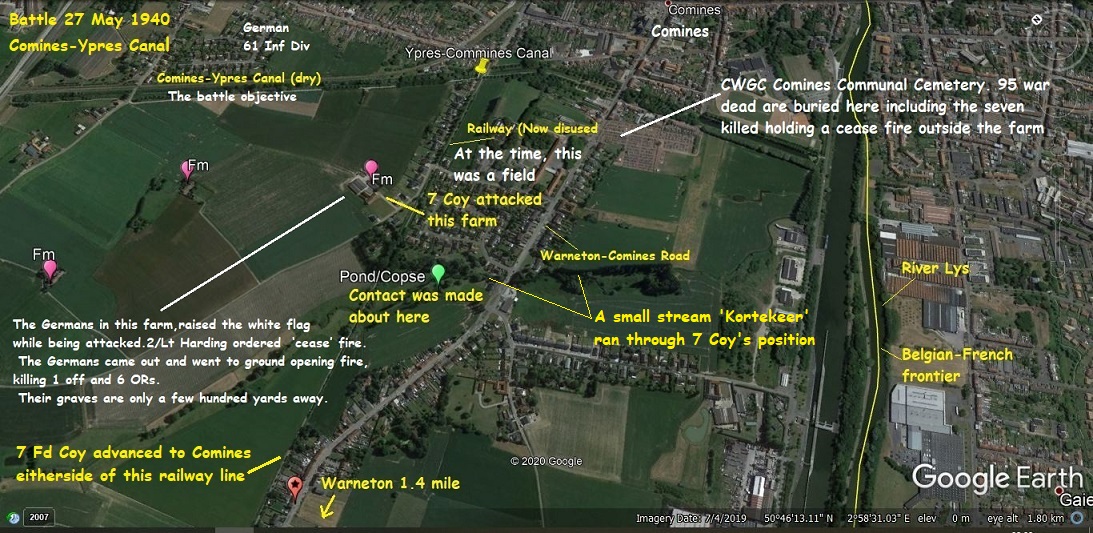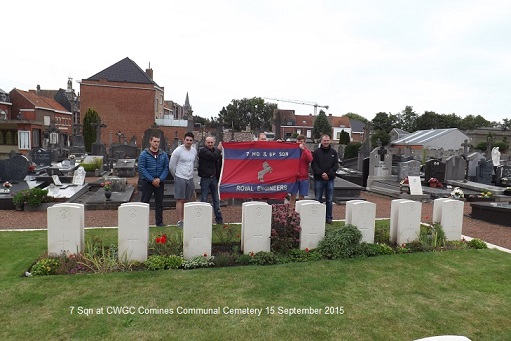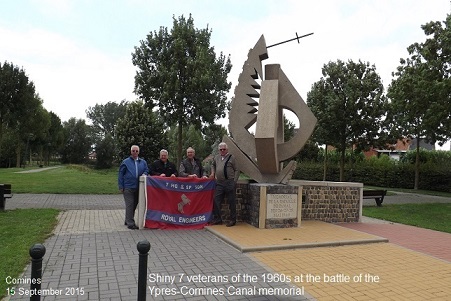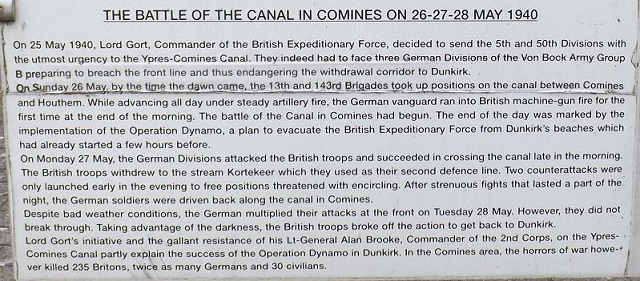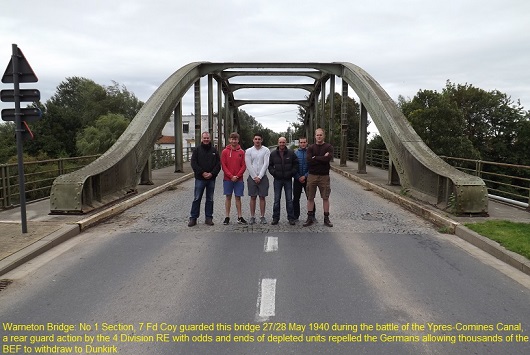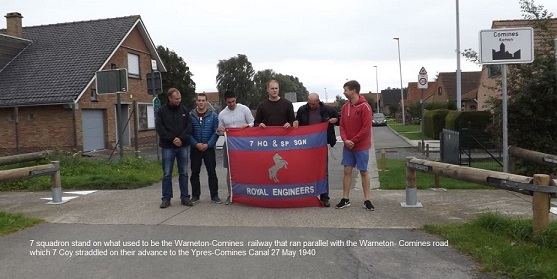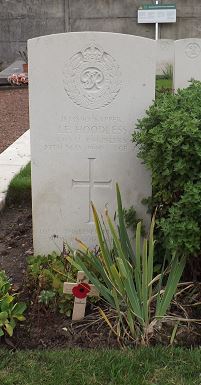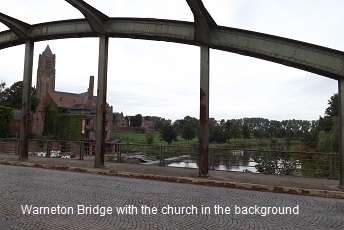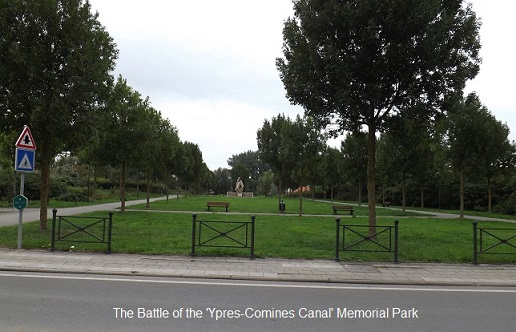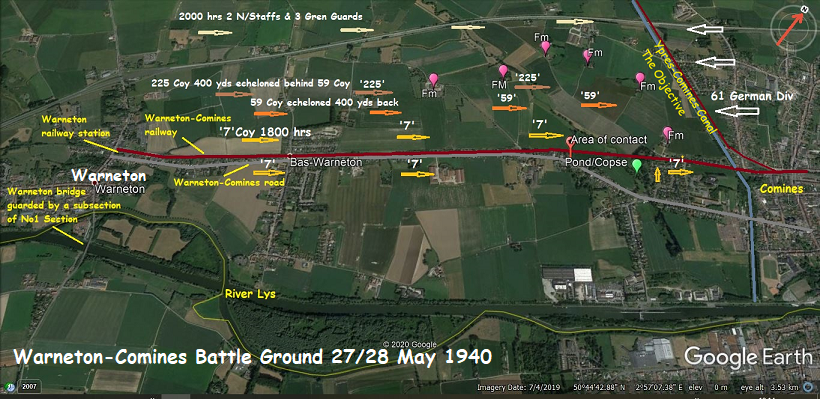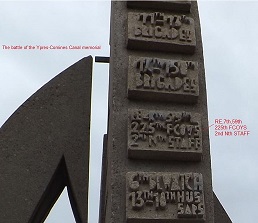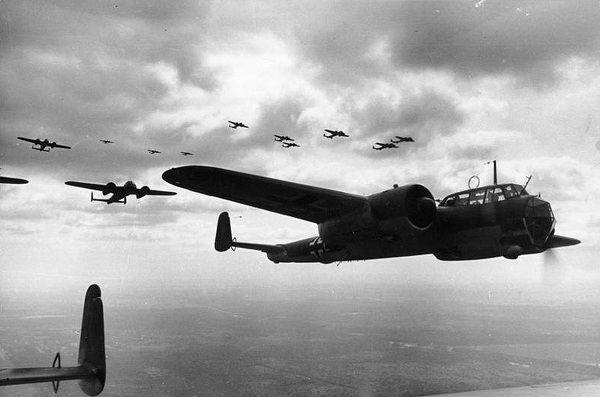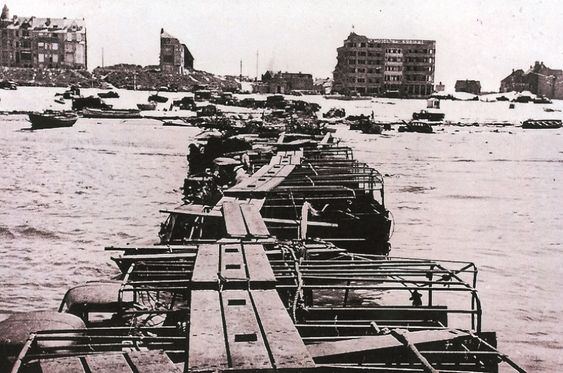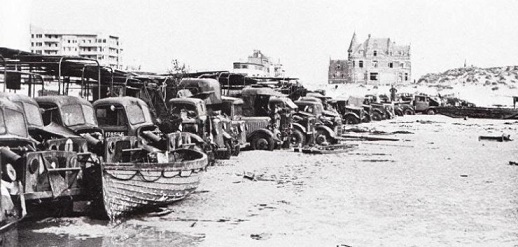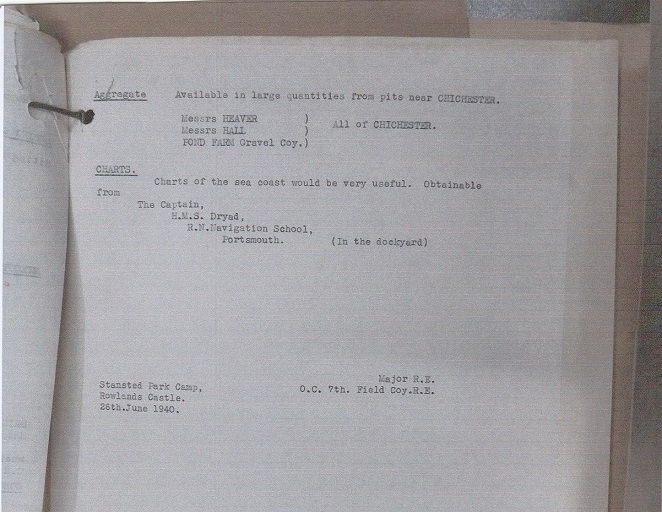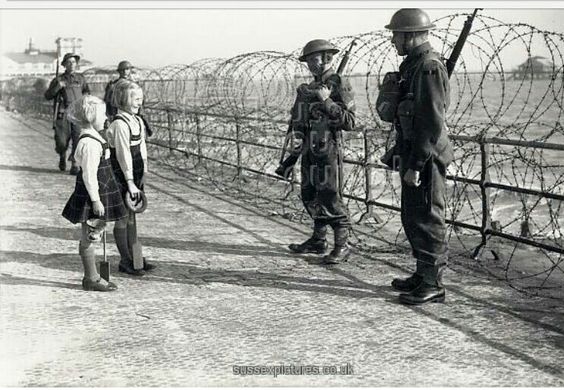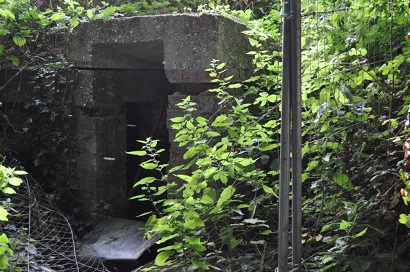On May 29th at the conclusion of the battle, Maj-General Franklyn issued a congratulatory order:
“The Commander II Corps has asked me to convey his warmest congratulations, and thanks to the 5th Division and to other attached troops who fought so gallantly on May 27 and May 28. It is in his opinion that it was entirely due to our action that the whole Corps was able to effect a withdrawal, and that, unless we held the Ypres-Comines Canal successfully, the safety of the whole BEF might have been put in serious danger. He emphasised his complete confidence that this fact will be confirmed in history. I am indeed proud to have had under my command such a splendid body of Troops. I offer my most sincere congratulations.”
(signed)
H E Franklyn
Maj-General
Commander 5th Division
In the Field
29th May 1940
The weather cleared as the convoy pulled out at 1700 hrs there were reports of Junker ‘87’ dive bombers on the road, however, they kept their distance from the’7’. As the convoy closed on the beach-head the full extent of the disaster became clear, spiked guns pointing to the sky, and as far as the eye could see there was a line on line of vehicles in flat open fields. RE and RA vehicles had dispensation the remainder were disabled, sumps were drained of oil, engines were run until they seized up then rotor arms thrown in the canal. The 7th crossed the canal at Furnes into the bridgehead as the sun went down turning north towards Nieuport, where the 12th Lancers were holding back the advance elements of the German 256 Div. the Lancers had withdrawn over the main bridge at Nieuport (prepared for demolition by 13 Survey Coy RE) 1 Section was ordered to recce the bridge at Nieuport while 2 section recced the canal and sank 8 barges so that they couldn’t be used by the enemy. As soon as Brigadier Hawkesworth (12 Bde) arrived he ordered the bridge to be blown. It was a comparatively large structure with built-in demolition chambers loaded with explosives by the Belgians, 13 Survey Coy RE prepared the demolition. The Germans were on the far bank but did not interfere as a party led by Lt Curtis 1 Section prepared the circuit, and then successfully blew the bridge.
29 May Wednesday. It was discovered that a small bridge, possibly a cattle bridge near Nieuport across the canal had not been blown. Lt Curtis was ordered to demolish the bridge with a party of six ORs from 1 Section. Pole charges were prepared to place against the structure, a recce was not possible. The plan was to move via ditches to the bridge. The party all volunteers, moved off in full daylight in bright sunny weather. Overhead a recce aircraft searched the ground and just north of Nieuport the all-seeing eye of an observation balloon was floating casually. There were no reports of the balloon either being shot down or attacked. In addition observers of the 256 and 208 DIVS occupied the highest vantage points in Nieuport. The 7th in contrast did not take advantage of the houses for observation and defence. The demolition party moved by ditches to the flood bank of the canal. It was necessary to cross a field. The party now came under well-directed small arms and mortar fire. Cpl Petter was wounded. Lt Curtis was wounded whilst bringing his back to cover a ditch. He then ordered the party to return to HQ taking Cpl Petter with them. Eventually, all the party were wounded including Lcpl R Venn, Sprs F Clark and S Wyborn, (it has not been possible to trace the names of the other two Sappers). Cpl Petter died from his wounds shortly after returning to Tac HQ. LT Curtis and wounded were evacuated. As a result of this action, Lt Curtis was awarded the MC.
The enemy appeared to use this sortie as the moment to signal his intention to make an all-out attack from the south of Nieuport, across the canal in the direction of the positions held by the ‘7’, firing continuous air bursts over a wide area. As the majority of the defenders were in the open and had no overhead cover, there was a steady trickle of casualties. Mortars searched the ground striking at the forward positions. MG fire poured in bursts down the road. Snipers crossed the canal taking up positions in houses between the main ‘7’ position and the transport. They were active accounting for the CO of the 2 RF who were unable to deploy due to the bullet swept ground near the unblown bridge where the attack came in at 1300 hrs. The RF successfully savaged the German attack with their carriers sealing off the bridge being used by the Germans. ‘7’ held on grimly as the pressure built up. At one point a Bren with CSM Gilbert acting as a spotter cooled the ardour of an OP party in a high building in Nieuport. Detachments of the ‘7’ were withdrawn as the infantry took over from the sappers in their original positions, none of which had been lost. The party withdrew at dark consisting of the A/OC, 2/Lt Simpson, the CSM and 35 ORs. Spr/Dvr D Pitt returned with his truck to Nieuport searched for and found Sprs O’Halleron, Stamper and others who had missed the MT.
Casualties at Nieuport were Cpl Petter killed, Lt Curtis, Sprs F Clark, T Lees, (Tich) Parry, M Riell, Cpl T Riordan, Lcpl R Venn, Spr Wyborn and a further 13 other ranks were wounded.
30 May Thursday. The first detachments withdrawn from Nieuport went direct to La Panne, where sappers from another unit were building a lorried pier. Sgt Cutler turned up to greet the hungry sappers with tea and food to cheer them up; they then got down as La Panne was hit by shells and aircraft made their presence felt in overcast conditions and reduced visibility. Orders were given to move north to Coxyde where a reserve line from the Furnes Canal to the sea was to be built and manned by 4 DIV RE, under the command of Lt-Col Horrocks 11 Bde. Brigadier Anderson had left to command 3 DIV. Maj-General Montgomery was now in command of II Corps as Lt-General Brook was ordered home to take up another command. Amid cheers the move to Coxyde was cancelled, the drivers had cheered too soon as they were required to ferry troops from Coxyde to La Panne. The A/OC and a party arrived at Oost Dunkirk from Nieuport at 0600 hrs and Coxyde at 1230 hrs, recces were carried out for wire and digging tools for the reserve line, which was begun to be built in the evening. At 2300 hrs the A/OC and his party moved to La Panne, where 5 DIV RE had begun to build a lorried pier decked with chesses and other suitable material. During the evening at La Panne, the Divisional Commander made the following immediate rewards.
CRE Lt-Colonel Coxwell-Rogers DSO, The OC Major Gillespie MC, The OC ‘59’ Major Macdonald MC, Sgt Cutler and L/Sgt A Vodden MM.
Some of the ‘7’ casualties in the CCS at La Panne saw the 5 DIV RE working on the pier. In the afternoon ambulances were loaded at the CCS moving off on a long lurching journey. When the ambulances halted and the rear door opened to unload, it was found to be back where it started from. The ‘CCS’. About this time it was decided that the wounded could no longer be given priority as stretcher cases took the space of two standing men on board ship. Stretcher cases were to be collected and left near Dunkirk, although stretcher cases and walking wounded were evacuated the whole time. Enemy aircraft made a special target of hospital ships in spite of the Geneva Convention being strictly adhered to by the allies. The CCS at La Panne was acting as a General Hospital marked with large red crosses. Even so, it took its share of near misses from shells and bombs as it was bound to do. Inside the atmosphere was one of absolute calm. Orderlies brought food to the wounded in their wards. (small hotel rooms). The lucky ones were two to a bed laid fully dressed. A large room dark drapes on the ground floor was used for the more seriously wounded. A theatre adjoined it working overtime. Surprisingly there were French and Belgian girls in the basement selling bottles of Vichy water at a tremendous price per bottle. There was a real shortage of water. Water bottles had long been emptied. Cash was pooled in the six man ward each from a different unit, two of them went down to join the queue of thirsty. Hungary, bandaged men, taking their turn to hand over a fist full of Francs for something they could easily have taken by force. Two bottles were taken back to the ward and shared out.
31 May Friday. Monty commanding II Corps had given his opinion, stating that II Corps could not hold the perimeter east of La Panne beyond the night of 31 May/01 June. 3rd and 4th DIVS were ordered to thin out that night, May 31st. They withdrew to La Panne embarking from lorried piers built by the sappers. If those piers became untenable then lorried piers at Bray-Dunes were to be used. Failing that, priority would be given to embark II Corps at Dunkirk by ship. In the meantime, the enemy would be shelled, bombed and viciously counter-attacked. 10 Bde commanded by Brigadier Barker, 12 Bde and 1st E Surrey’s held continuous counter-attacks. At one point the Germans laid a large smokescreen which blew back on their own positions, and as a large force formed up to attack, ‘Blenheims’ of the RAF flew in to drop bombs on the enemy causing a large number of casualties halting the attack. During the evening Maj-General Alexader, GOC I Corps took command of the Beach Head as Lord Gort embarked for the UK on the PMs orders.
At 0800 hrs the A/OC and party arrived at La Panne and assisted in the preparations for embarkation. One lorried pier was partly completed from which a few boatloads embarked up to 0900 hrs when the sea became choppy and the waiting ships stood further offshore. Several rowing boats over-turned and their occupants were lost, boats were overloaded, there was no proper control. At 1000 hrs, ‘7’ were ordered to cease works on the beach and move to Dunkirk. II Corps CE countermanded this order at 1025 hrs. He ordered the remnants of 3, 4, and 5 DIVs RE to complete the first pier and to build a second pier. At 1200 hrs 4 DIV CRE arrived on the beach after visiting 10 and 12 Bdes to give details of the reserve position prepared at Coxyde. He now took charge of embarkation arrangements and issued orders that no further boats would be put out until dark. One report put out that the ‘7’ were too tired to be of much use, however, the remnant two officers and over 40 ORs worked on the completion of the first pier. At 1530 hrs a stick of four bombs fell. Lt-Col Le Sueur, Capt Hodgson, Sprs Brazier, Carthey, Chuter, Hall, Dvr Knowles and Cpl Sykes were killed and nine ORs of the 7th were wounded. Dvrs Meakin, Matthews and Thrift were reported missing. The enemy observation balloon could be seen from La Panne floating near Nieuport. Medium shells halted work on the piers at 1630 hrs and at the same time the CRE reported to the GOC 4th Division that there were only ten serviceable boats including assault and FBE boats to lift the Division from the beach to the ships. Naval officers reported that their boats would come ashore at dark. At 2000 hrs the sea became calm, the ‘7’ were ordered by the CRE to embark which they did from Bray-Dunes. General embarkation got underway at La Panne at 2130 hrs and by 2330 hrs 600 men of 12 Bde had been embarked when there were very few boats left. At 2359 hrs the CRE informed the GOC 4TH Division that unless ship’s boats came ashore further embarkation was impossible.
01 June Saturday. Maj-General Johnson GOC 4th Division rang Admiral Ramsey at Dover asking for boats to come ashore as embarkation was at a standstill, and that rear guards of the Division were withdrawing in contact with the enemy. It was agreed that ships would meet the Division at Dunkirk. Final orders were given at 0200 hrs for the Division to walk down the beach to Bray-Dunes and if necessary to Dunkirk. By this time La Panne was ablaze, shells were hitting the piers, all kinds of debris littered the beach, and as the tide came in it washed ashore bodies, greatcoats, personal equipment, damaged boats, craft, cars etc. Embarkation from the beaches in daylight was no longer possible. About 0500 hrs enemy aircraft strafed the beach in front of the advance elements of their advancing troops causing casualties among the rearguard. Apart from the advance party who left on the evening of May 26th the majority of the 7th embarked from the beach one way or another, some from lorried piers, others by wading out to boats, a number, including Capt Vaughan-Williams swam out to the winking ships stood about half a mile from the shore. Those sappers who did not embark from the beach walked the 10/11 miles to Dunkirk where the navy was at the East Mole to lift the last elements of the Division, some of the 7th were embarked sunk and rescued by another ship. In this period the East Mole was under continuous air attack, Sprs Tracey and West were killed. There is no information about their loss or of Spr Wood lost May 29th.
The Grenadier Guards and their adopted Sapper (Rayner) marched to the Mole, as they passed Maj-General Alexander they gave a smart ‘eyes right’. The general returned an equally smart salute. After much discussion, the French finally agreed that the British rear guard would withdraw in equal numbers with the French in the hours of darkness 1st/2nd June. The BEF had held the main burden of defence without which there could have been no large scale evacuation. Firstly holding ninety miles of the 120-mile front giving both the British and French time to withdraw to the beach-head. They had held the major portion of the perimeter. The French now covered the final withdrawal fighting an outstanding battle, by mischance the French troops went to the wrong Mole at Dunkirk.
02 June Sunday. In spite of going to the wrong mole, more French than British troops were landed in the UK on this date. The last British rearguard was drawn tightly around Malo by Major-General Alexander to hold through the hours of daylight to embark at nightfall. At 2300 hrs Capt Tennant RN, the Naval Commander ashore at Dunkirk signalled to Admiral Ramsey at Dover, ‘BEF evacuated’. Operation ‘Dynamo’ was at an end. Major-General Alexander searched the beaches, calling from a loud hailer for any stragglers without success.
03 June Monday. The night’s effort had yielded 7000 British and 20000 French troops landed in England. Admiral Ramsey agreed to mount one last effort that night to lift the French rearguard.
04 June Tuesday. Due to a rabble of French soldiers emerging from the cellars of Dunkirk the French rearguard which had held their positions at Bray-Dunes were prevented from embarking. Many ships returned empty, even so, over 26,000 French soldiers were landed in England.
At 0900 hrs. General Beaufrere made the formal surrender, according to German sources the number of troops taken prisoner was 30/40,000.
The best estimate of the strength of the Shiny 7th on the beach before the order to embark was 2 officers and 80 other ranks. In addition to awards recorded, CSM R Gilbert and L/Sgt Green were ‘Mentioned in Dispatches’.
|
Date |
Rank and Name |
Place |
Cementery |
|
|
16 December 1939 |
Lt B C Reiss |
Benthune |
Beuvry |
Communal |
|
27 May 1940 |
Spr S W J Black |
Warneton |
Comines |
Communal |
|
27 May 1940 |
L/cpl H A Bonner |
Warneton |
Comines |
Communal |
|
27 May 1940 |
Spr H Bothwick |
Warneton |
Comines |
Communal |
|
27 May 1940 |
Spr W F Froude |
Warneton |
Comines |
Communal |
|
27 May 1940 |
2nd Lt V Harding |
Warneton |
Comines |
Communal |
|
27 May 1940 |
Spr J E Hoodless |
Warneton |
Comines |
communal |
|
27 May 1940 |
Spr/Dvr L Shepherd |
Dozinghem |
Westvleteren |
|
|
27 May 1940 |
Cpl T Trice |
Warneton |
Dunkirk |
Memorial |
|
27 May 1940 |
Spr F Vollans |
Warneton |
Dunkirk |
Memorial |
|
27 May 1940 |
Spr W H Whitwell |
Warneton |
Comines |
Communal |
|
29 May 1940 |
Cpl W E Petter |
Nieuport |
Dunkirk |
Memorial |
|
29 May 1940 |
Spr A Wood |
|
La Panne |
|
|
31 May 1940 |
Spr R I Brazier |
La Panne |
Dunkirk |
Memorial |
|
31 May 1940 |
Spr L G Carthey |
La Panne |
Dunkirk |
Memorial |
|
31 May 1940 |
Spr F L Hall |
La Panne |
La Panne |
|
|
31 May 1940 |
Dvr T Knowles |
LaPanne |
La Panne |
|
|
31 May 1940 |
Dvr A T Matthews |
|
Dunkirk |
Memorial |
|
31 May 1940 |
Dvr H J Meakins |
|
Dunkirk |
Memorial |
|
31 May 1940 |
Cpl G P Sykes |
La Panne |
La Panne |
|
|
31 May 1940 |
Dvr J Thrift |
|
Dunkirk |
Memorial |
|
01 June 1940 |
Spr J Tracey |
|
Dunkirk Town |
|
|
01 June 1940 |
Spr J T West |
|
Dunkirk Town |
|
|
|
|
|
|
|
|
31 May 1940 |
Lt-Col J H R Le Sueur
CRE 5th Divsion |
La Panne |
La Panne |
OC 1939-40 |
|
31 May 1940 |
Capt H P E Hodgson
Adjutant 4th Division HQRE |
La Panne |
La Panne |
2i/c 1939-40 |

|
Date |
Place Event Campaign |
|
Jun 1940 |
Martock, Somerset / Rolands Castle, Dorset |
|
Jul 1940 |
Northlands |
|
Nov 1940 |
Crawley Court, Hampshire |
14 June 1940. There are no further entries in the Company War diary until this date, by which time the Shiny 7 had moved to Martock in Somerset, where the 4th Division were reforming. The 7th was housed in a tented camp. The advance party had been there since 02 June. The battered, unbowed 7th morale was soon restored by fine weather, regular food, rest and a short leave of 48 hours. The local people were very hospitable and supplied the men with more than plenty of cider.
Invasion was in the air and the ‘7’s tasks were to build defences in the south of England. This was the same reason, (invasion) for which the Company was embodied on January 1st 1805 as the ‘7th Spike Island Company’. Until that date Companies were known by the place where they were stationed and did not have a number. Their first task under Lt Colonel Sir Charles Holloway was to demolish Westmoreland Fort on Spike Island, County Cork, and build defences to secure the port of Cork against attack.
14 June. Major Walkey became OC. The 2I/c was Captain Vaughan-Williams.
Sections: 1 Section Lt E V Rambush. 2 Section, 2nd Lt Warmesley-White, 3 Section, 2nd Lt J A Simpson. Reinforcements: 2nd Lt H Hanbury-Brown, 2nd Lt A G Marsden. The arrival of many reinforcements including a large contingent from Elgin gave the 7th a distinct Scottish flavour. Over 25% of the company were Scots and this continued for several years. The Company tactical serial number changed from 19 to 49. A steady trickle of casualties returning boosted the Company strength well above the establishment of 250 ORs to 315.
20 June. The Division came under command of V Corps, the GOC Lt-General Auchinleck, the Corps sign was a Viking Ship.
21 June Friday. At 1115 hrs the Shiny 7 left Martock in hired transport to another temporary home at Rowlands Castle. They joined 2 DCLI in a tented camp. A move of 300yds was made to maintain the Shiny 7’s identity as a separate unit. The Company were under command of 10 Bde, in support of the Brigade Infantry, 2 DCLI, 1 RWK, and 2 Beds & Herts in defence of the beaches from the River Itchen to Hayling Island. Later to be changed to, exclusive of Hayling Island, inclusive of Bognor Regis and then inland for some miles. All personal weapons and equipment were made good but transport was slower in arriving. The GOC toured the area raising the standard of defences and at this time a shake-up of the commanders began rolling on until 1942. Toward the end of June Maj-General Eastwood became the GOC of 4th Division.
01 July. Lt Rambush became acting 2i/c. Recces were completed in the first week of the month and work on the defences began. Civilian contractors worked under supervision, constructing 5’ concrete cubes to block beach exits and on four A/T pillboxes. Civil authorities were responsible for blocking landing grounds that had been recced, and they were instructed to steel shutter the banks of the Chichester canal, which was to be filled with water. They began to dismantle three spans of the Bogner pier and two bridges over the Chichester-Rife canal.
08 July. 1 Section moved to Nyetimber and 3 Section to Batchmere Farm, Birdham. Both Sections were housed in Land Settlement huts and private houses.
11 July. Work on defences proceeding. A/T Block production limited by lack of cement. Bognor pier, 3 spans dismantling completed.
12 July. Two bridges over Chichester canal dismantled.
13 July. 10 Bde decided that Selsey Bill was to be held and ‘not flooded’. Orders were issued to stop the flooding programme. The next day 2 Section moved to Northlands near Chichester, HQ into a house and the Section under canvas. Overhead the air battle began. Attacks were made on shipping with the aim of denying the use of the channel to all shipping. The admiralty was prepared to accept losses to prove that ships could use the channel in daylight in spite of the Luftwaffe. The enemy flew recces night and day in preparation for a major attack. The PM continued to rally the nation, declaring on the 14th of July: “ We are fighting by ourselves alone, but we are not fighting for ourselves alone”.
16 July. Hitler issued Directive No 16, for ‘Operation Sealion’. The invasion of England.
21 July. Lt-General Sir Alan Brooke became C in C Home Forces. Lt-General Auckinleck became GOC Southern Command and Lt-General Montgomery GOC V Corps. The Company continued with its tasks building defences. Most beach exits had been blocked and fields of fire extended and cleared by the removal of some buildings and obstacles. Civilian Contractors were engaged, happily working six days per week. The GOC v Corps inspected the defences and was satisfied with the work completed and the work in hand. He directed that 50% of the Division would work and the remainder train. A keynote in training was fitness training. In his view, the Division must train to a very high standard. If the Germans could only fight in day time then we would train to fight in day and night time in all weathers. A new spirit was on board. All ranks went on courses, unarmed combat, engineering, bridging, Battle Schools came into being and were as near as possible to the real thing. Training took on a new live aspect.
01 August. The air battle was hotting up. Recces were made to lay minefields along Selsey Bill from East Wittering to Bognor. In the evening NCOs from 3 Section were called together at Batchmere Farm and instructed on the laying and arming the notorious Naval Beach Mine B type C. Laying would commence in the morning in the area of Thorney Farm now Great Ham Farm. Each mine weighed 50lbs of which 20lbs was explosives. In the armed state 25lbs on the side of the lid or 50 lbs on the top of the lid activated the mine. They were both an A/T and A/P mine. In the morning two Sub Sections went to the beach near East Wittering and met by the OC and the Section OC to commence laying a minefield. The minefield was wired on all sides by barbed wire attached to wooden pickets dug into the pebble beach above the high tide watermark. Signs were fixed except on the front fence.
28 August. The minefields were going very well. 1,014 mines had been laid to date. 2nd Lt Brown returned to unit.
30 August. The Home forces were alerted, ‘Invasion expected within three days’. If and when codeword ‘Cromwell’ was received all troops would go to battle stations. The invasion ports began to fill with invasion craft, and the Navy and RAF attacked them.
01 September. HQ and 1 Section went out on Divisional exercise and there would be trouble if the Corps Commander came across any sapper who was not ‘In the picture’. 2 and 3 Sections continued mine laying.
04 September. The 1/6 E Surreys were relieved on the beach east of Wittering by the 2 DCLI. About 1800 hrs a number of explosions were heard at Batchmere from the direction of the coast.. shortly afterwards L/Sgt Vodden and three NCOs headed for the beach near East Wittering where the first mines were laid. Pte Couch of 2 DCLI had walked into a minefield after climbing through the wire fence on the seaward side. Four mines exploded killing Pte Couch. Mines were disarmed to recover the body from the minefield. It is thought he was taking a short cut to his next post.
07 September. At 2345 hrs the codeword ‘Cromwell’ was received, the 7th stood to, 1 section raced to Thorney Island causeway ready to fire the demolition charge that they had prepared previously. The attack never materialised and everyone was stood down.
16 September. There were more casualties in the minefields three ORs of V Corps HQ Royal Signals were killed in the area of Pagnham Harbour at 2200 hrs. at 0045 hrs the minefield was made safe and the bodies recovered.
17 September. Hitler decided to withdraw the order for ‘Sealion’ though the threat remained and the troops would continue training for the invasion. Panzers and airborne troops were withdrawn eastwards. Invasion craft would return to less turbulent waters. The Navy and RAF had destroyed 10% of the invasion craft though this had no bearing on Hitler’s decision to cancel ‘Operation Sealion’.
28 September. 3 Section were withdrawn to HQ, I Section took over from them at Batchmere. The next day 2nd Lt Simpson left for the Middle east. And 2nd Lt Marsden became OC 3 Section. The month ended with ponies being killed in the mine belt near east beach Selsey.
October. Major-General Swayne took command of the Division as it was being pulled back from the beaches and its roll changed to a mobile counter-attack force to strike the enemy wherever it may appear in the Corps area.
4 Division TRF
7 Company was in
4 Division during
this period
Shiny 7 History 1940
Three weeks to La Panne.
Diary notes made by Lt R. L. Clark RE, a 4 Division HQRE intelligence officer
http://www.foxearth.org.uk/ThreeWeeksToLaPanne.html
RE Cap Badge during this period
King George VI 1936-1952
Nissen huts can be seen on the right of the picture
Selsey Bill
21May. Small parties went forward to continue work on defences, all movements were observed from the high ground at Mont de l’Enclus. Whilst working forward a party found some musical instruments, they formed up and marched down the village towards the Escault. 19 Div soon dispersed Spr E Blunt’s band. Drum sticks were used as splinters on the arm of one of the wounded. Lcpl Jupp and Spr Mercier were both evacuated. Enemy guns also registered Coy HQ without causing casualties. It was becoming impossible to work forward in daylight. At dusk, a section went forward to erect hessian screens strung from trees on the roadside leading to the Escault. A subsection posted in pairs kept a sharp lookout and a Bren covered the road. Enemy patrols crossed the river to recce as a prelude to an attack but did not make contact. The work was completed without incident after an edgy night. The BEF launched an attack on Arras with the object of breaking through to join up with the attack from the south by the French, The attack was a success. The SS Totenkopf Div was given a bloody nose. 400 POWs were captured from them and taken back to England via the beaches north of Dunkirk. The German 7 Armoured Div commanded by Maj General Rommel was bumped, he ordered every available weapon that could be brought to bear, including his 88mm A/A guns in their dual role as A/T guns to fire. In order to try to halt the advance of the 4 bn RTR tanks. At one point British and French tanks mistook each other for the enemy adding to the fog of war. Finally Maj General Martel in command of the tanks and 50 Div reported, the force was not strong enough to hold the ground captured in the ten mile advance. The French agreed to provide two divisions for the attack but did not do so, and the projected attack from the south did not materialise. The Germans had a scare, certain that the advance would be exploited, and thought that their infantry divisions, which had horse drawn transport would not be able to reach the area to save the armoured divisions. They called a temporary halt of the armour until the infantry closed up. Ironically this same day the long awaited 1 Armoured DIV began to land at Cherbourg south of the Somme, too late to influence the impending result of the campaign. The French Seventh Army was running out of ammunition to say nothing of other supplies. The BEF had three days of supplies left. Each ally knew exactly where events were leading and what the final destination would be.
22 May. In the dawn mist Lt Curtis lad a party of 1 section down to a branch of the river Escault held by the 2 LF to demolish a brick arch. Locks were left intact as it was thought that if the locks were either opened or demolished the Escault would run dry. After completing the job Lt Curtis reported to the Fusilier HQ, which was hit by a salvo of shells just after he left killing the CO and Adjutant. This was the first of a series of stonks which methodically hammered HQs and other targets prior to an attack at 1500 hrs. 1 section was chased up a slope to their transport by mortars and shells. A vehicle of the 7th ditched on the forward slopes could not be recovered due to heavy stonking. BEF was put on half rations, provided time was available to forage this was not too much of a hardship. Many houses were deserted, animals left had been left to fend for themselves, some were injured or slaughtered by enemy shelling.Firing parties were sent out to three bridges over the Courtrai/Bossuyt Canal, which falls by means of locks from Courtrai into the Escault at Bossuyt. The demolition had been prepared by the RE of 44 Div. The bridges were successfully blown from the SW bank of the canal. The Sappers then pulled out and caught up with their sections the next morning. Boulogne, Calais and Ostend were out of action as ports and the water supply at Dunkirk was destroyed. A greater part of the railhead transport had been captured. All general hospitals had been cut off from the forward areas since May 20th. in spite of this hospital, trains ran until May 26th and hospital ships berthed at Dunkirk until May 31st / Jun 1st.
23 MAY. As the mist gave way to a sunny day the 7th arrived at Le Halct south of Wervick on the frontier back were they started. The division was in II Corps once again on the left of the BEF with 3 Div on their right. The 7th was in support of 12 Bde on the left of the division. The Belgians held the line from where it hinged north to Ypres at Comines and the disused Ypres-Comines canal joined the river Lys. The Belgians were being pushed back rapidly by the advancing Germans. Sections quickly set about digging positions, erecting a double apron barbed wire fence, clearing buildings and other structures in the line of fire. 2 section laid the only minefield put down by Shiny 7 in the campaign. Shortly after it was laid a very senior officer was seen in the minefield, he was halted mid-stride, one leg up in the air, he was safely led out. Sections manned the defences until the arrival of the Bde infantry who were withdrawing from the Escault position. British and French troops were withdrawn from Arras. All of the 4 Bn RTR tanks were out of action except two. Calais was cut off to save supplies, base troops who could no longer contribute to the battle were evacuated via Dunkirk, which was under continuous air attack, Goering had said the Luftwaffe would deal with the BEF and defeat any attempt to evacuate.
24 May. 12 Bde infantry relieved the 7th manning defences at 0100 hrs. Sappers put down their rifles to work on defences, making loopholes in buildings for MGs. Lt Clarke led 3 section to a site near the Halluin-Menin bridge which was blown. To the north of the Division, the Belgians had withdrawn leaving the way clear for the German IV Corps to exploit at will. Enemy patrols were expected at any time. The section built a double apron barbed wire fence on the bank of the river Lys in complete silence. A frog farm close to the site made the most noise. 2 section were clearing lines of fire and sinking barges. 1 section had the thankless task of moving civilians from their homes in a terrace of houses to clear a field of fire. A patrol of the 1/7 Midd’x MG Bn, crossed the Lys between Comins and Menin, shot up a large car and grabbed a briefcase from the car. The patrol succeeded in withdrawing across the lys bringing with them a wounded OR. The briefcase contained plans of the German attack, their order of attack, which was now being mounted by IV Corps with the 61, 31 and 18 Infantry DIVs across the front of 4 Division aimed at Kemmel. The whole German Army in Belgium was wheeling left with the object of cutting off the BEF and linking up with the armoured forces in the south. Hitler issued Directive No13. The order of total victory.
No. 1 The destruction of the Belgian, French and the BEF.
No. 2 Then as soon as possible the remaining French forces
It was agreed by the allies that a breakout to the south was not feasible due to the weakness of the Belgians.
25 May. At dawn, the 7th witnessed a spectacular air battle against the rays of the rising sun. the outcome was not known. As jobs were finished Sections made for detached locations on farms to eat, clean up, catch up with sleep, then make and mend. At this time the Germans were closing in, their pincers were only 10 miles apart. The French 1st Army were under continuous bombardment and they had lost all their heavy guns. They were almost out of ammunition and there were no bread rations. General Blanchard gave the order to withdraw to the coast.
26 May Sunday. At home, this was a day of national prayer. The BBC broadcast a message heard by one or two of the 7th, “That there would be no news of the BEF for a week.” The news caused a lot of comment amongst the sappers. The war cabinet had endorsed Lord Gort’s decision to evacuate, and the French PM was asked to make a similar order. As if to confirm the order Calais fell after a fight to the death. During the Siege, a German officer demanded an answer to an ultimatum to surrender. Brigadier Nicholson replied: “There can be no answer as it was the British Army’s duty to fight as well as the German Army’s.”
All-day long in perfect weather conditions bombers flew overhead to drop their loads on Armentiers an important junction of roads. 3 section mounted a Bren in a field In the hope of shooting down an aircraft but it was a fruitless effort, the distance was too far. At 1800 hrs Section ‘O’ Groups were told that the BEF and eight French Divisions were almost surrounded and that some HQ vehicles and NCOs had left for the coast to go home at once to train new units in our place and to tell them we had done our best. The feeling was we will fight our way out. Sections moved off at 2300 hrs in a thoughtful, determined mood forming a Company convoy in dry weather heading for Marieburg near Ploesgsteert a haunt of the 7th in the previous conflict. During the hours of darkness, guns could be seen firing to the left and right as the convoy rolled through the neck of the closing corridor on roads clear of vehicles and people. Thankfully the Luftwaffe were asleep. That evening operation ‘Dynamo’ the evacuation of Dunkirk began, commanded by Vice-Admiral Sir Bertram Ramsey from Dover. At the time the best estimate of numbers which might be evacuated was 20/30,000. Dunkirk was a shambles and due to air raids, the only means of landing much-needed supplies of water and ammunition was over the beaches where dumps built up. There was complete accord between Lt General Adam and French Commander General Fagalde as to how the perimeter would be held. Basically, the 60 French DIV would hold Nieuport in the north, the BEF exclusive Nieuport to Bergues and the French exclusive Bergues to Dunkirk.
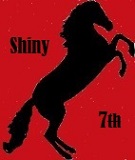
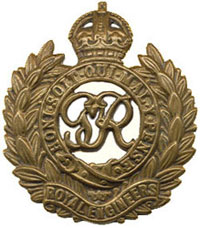
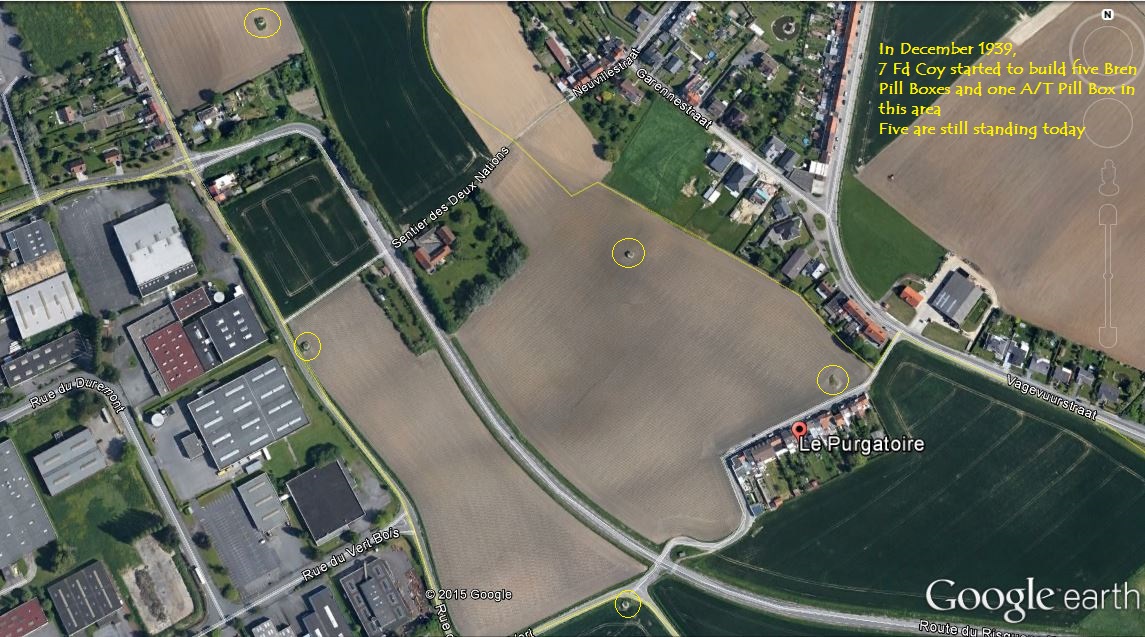
As part of the BEF 1939-1940, the Shiny 7th worked on numerous defences. Among other stores, there was a severe shortage of anti-tank mines. Their main work was A/T ditches, roadblocks, wiring defensive positions, clearing lines of fire, demolitions and from the 7 December 1939 until 9 May 1940 they were engaged in a major programme building different types of Pill Boxes. Some of the Pill Boxes still stand today.
At Bray Dunnes and La Panne, sapper parties from different Divisions worked together to build lorry piers. These were an improvised pier made up of lorries parked nose to tail going out to sea as far as possible when the tide was out. Pieces of beach huts, tailboards and engineer bridging equipment were used as a catwalk secured on the vehicle's superstructure. The idea was to shorten the distance from the shore to the bigger boats/ships, hastening the evacuation. A party of 7 Fd Coy helped build a lorry pier at La Panne 31 May 1940
German troops inspect a lorry pier
British troops on the Dunkirk Beaches May 1940
An improvised pier at La Panne built by the Royal Engineers
The Intellligence Report below illustrates the equipment shortages at the time.
21 October. 262 Army Fd Coy RE took over from the 7th on the coast. Two days later 3 Section moved to Northwood Park a few miles north of Winchester and set to work to clean up this large country house overrun with rats. Four days later the remainder of the Company arrived. Northwood park was used as a base to work on a new location at Crawley Court. Nearby was the village of Crawley. The local people were very amiable, the 7th was lucky to be billeted there.
Source: 7 Field Company war diaries
Tommy Riordan's book:
A History of The 7th Field Company RE 1939 - 1946
Photos IWM
The report below illustrates the situation at the time
01 Feb. The ground was frozen solid to a depth of 2’. Welfare facilities increased, the ENSA put on shows in Lens and Lille. Home comforts, pullovers, socks, balaclavas, gloves, mitts and free issue cigarettes arrived by the box load. Sections went out at night repairing damaged roads, which caused substantial subsidence. The OC was promoted to CRE 5 Division, Captain Hodgson posted to HQRE and Spr Taylor to the UK as an instructor. Major Gilespie became OC on March 16th for the remainder of the campaign. The 9th Fd Coy RE left the Division and was replaced by 225 Fd Coy RE.
09 May. An exceptionally fine day and completed pillboxes were camouflaged. Warnings were received by the Allies that the German forces were closed up at their jumping-off points ready to attack. The direction and numbers were given. The French 1st army was put on alert. Many of these troops were out on the farms helping out in the fields.
10 May. In the early hours ‘Fall Gelb’ was signalled by bombs exploding in Lille, Arras and other cities. No bombs fell near the 7th Coy billets. The enemy was moving forward into Holland, Belgium and France. Within hours the 12th Lancers were leading the BEF race forward across Belgium to the River Dyle, from prepared defences to no defences. A complaint was lodged in London by the Belgians that our forces had crossed the frontier uninvited!! One blessing is that the fifth column had not done their work yet, causing hordes of people to take to the roads. Lt Pawle was posted to HQRE. The Company officers were: OC Major Gillespie, 2i/c Captain J Vaughan-Williams. Sections: 1 Lt A D E Curtis, 2 2nd Lt J Simpson, 3 2ND Lt V Harding. Advance Parties were given 2 hours notice and the Company 6 hours notice. Pillbox sites were cleared up, machinery immobilised, starting handles and keys collected ready to handover to the 2nd General Construction Bn RE. At home, the RT Hon Mr W S Churchill became Prime Minister and three days later made a rallying speech in the House of Commons making now, the famous phrase: “I have nothing to offer but blood, tears and sweat.”
11 May. The Division would occupy a reserve position on the canalised river Senne from Brussels to Vivorde joining there with the 5th Belgian Division and would move in two days. Arrangements were made to evacuate non-essential civilians from the frontier areas. It can be said that the 7th were no strangers to Flanders. On March 16, 1793, a Company was formed from detachments of the other 6 Companies in the UK and named the ‘Flanders Company’. At that time Companies were not numbered but known by the name where they were stationed. The ‘Flanders Company’ was the seventh formed and the first sent abroad to support the Army on an ill-fated mission in the first campaign of the Napoleonic wars. The OC was Captain Gother Mann RE, under command were 5 NCOs, 30 Artificers, 50 Labourers and 1 Drummer. They did good work, sometimes supervising a labour force of 14,000 building defences. Once the French decided to attack the whole force was pushed back to Holland, eventually returning to Woolwich on 5 May 1795 under their OC Capt Johnson. The ‘Flanders Company’ was disbanded and split up amongst the other six Companies.
12 May. Lt Harding left to recce bridges on the Willebreock canalised river Senne from Brussels to a point a few miles north of Vilvorde. 3 Div of II Corps were holding positions on the river Dyle covering Louvain. German forces had made striking gains in Holland. A devastating incendiary air attack on Rotterdam sealed the fate of Holland. Support from the RAF was planned from England, requests for attacks on targets had first to pass through the Air Marshal’s HQ. It would be difficult to think of a more cumbersome style of command. In contrast, the Luftwaffe were used as advance artillery for the spearheads, partially controlled by flying HQs (junker 52s) over the area of operations and had the necessary ground to air communications.
13 May. Lt Curtis left to Recce a concentration area NW of Brussels, where a Belgian horse-drawn artillery unit was occupying the wrong area. . After standing to from 1300 hrs the Shiny 7 moved off in dry weather at 2130 hrs. many of the locals waved them off. After crossing the frontier there was no evidence of refugees on the roads and the roads were clear. They drove on 'Dif lights' and no route cards were given below section OCs. They drove NW of Brussels. A detour was made around Almost due to an air attack. The 7th saw no signs of air activity for most of the journey.
15 May. The PM of France telephoned the Prime Minister to say that the Allies were defeated and requested help from the RAF in the way of bombing troop concentrations. The RAF bombed the Ruhr in the hope the Germans would recall their planes to defend their homeland. At this time Sections drove down to the bridge site to prepare the bank seats, level off ballast in barges, and manhandle a multitude of railway sleepers onto barges to build piers. The rumble of guns could be heard in the distance as 3 Div held back the enemy advance on the Dyle at Louvain. On the bridge site, SBG vehicles were unloaded, spans built and launched on to the floating piers.
16 May. At 0700 hrs the 7th were withdrawn, ‘225’ took over and completed the Bridge. During the afternoon the Shiny 7 went down to the canal line to prepare demolitions. Two bridges recced by Lt Clarke two miles north of Vilvorde were prepared and blown by 2 section in the face of the enemy who suffered some casualties. 6 Black Watch then handed over the sector to the 5th Belgian Division.1 section went to Vilvorde to deal with the main bridge, refugees were a hindrance and required severe handling. 3 section with another bridge at Vilvorde. The Pont Lever and SBG bridge, plus a number of barges and an unmarked tunnel discovered by the 2 RF. All bridges had to be ready for demolition by midnight. An air attack developed near the ‘Pont Lever’ as a lorry drew uploaded with three tons of explosive, a number of the party dived under the lorry for cover! The Belgian operating the lifting gear, without any warning lifted the bridge whilst Sprs J Stamper and J Kelly were loading ammonal in the chamber beside the counterweight. Spr Stamper was injured but did not leave the site. This bridge was to be used by the light tanks of 15/19 Hussars the rear guard, and a sapper guard was mounted to prevent anyone crossing the bridge. Two cuts were needed on the bridge, 25 kilos placed by the Belgians were incorporated in both the FID ring main and the electrical circuit. Camouflets were driven down on each abutment, but due to the sand fill, collapsed, therefore all of the ammonal was placed in the counterweight chambers and tamped down with sandbags. Due to a shortage, there were only 150 yds of electric cable, the exploder was in a shallow hole on the canal bank. A daunting prospect. 12 Bde Commander visited the site before midnight to ensure that all was well, by this time all the bridges were ready to fire.
17 May. After a dry night a fine day was in prospect, the demolition parties continued to work hard as they had done through the night. 2 section successfully blew their bridges, L/sgt Noble and party dealt with the tunnel and barges. After the 15/19 Hussar tanks crossed the SBG, Cpl A little and Lcpl W Farrimond blew the bridge, which disappeared into the canal. The electric cable used was passed to the Pont Lever, which enabled the leads and the exploder to be placed a reasonable distance away at the side of a house where 3 section Bren was in position. The OC and 2/lt Harding arrived and ordered the bridge to be blown at 1330hrs. The bridge was blown and the Bren team were ordered to shoot at the gasometre on the far bank in an effort to puncture it. The OC went to assess the bridge damage. The main girders were a tangled mass of metal hanging down in the water. A good percentage was under the water level of the canal. The OC did not want a second attempt to drop the remainder into the canal. He assessed it as 60% destroyed and only an active infantryman would be able to cross. The party moved back to base famished. At 2100 hrs the Company moved out west of Brussels. It was overcast and raining lightly. Refugees littered the roads pushing carts and bicycles load with their possessions. It was stop, start for much of the way. When the convoy halted the 2i/c walked up and down trying to keep drivers and front-seat passengers awake. German armoured spearheads continued their drive to the channel coast. Unless the French could collect a force to seal off this drive, the northern allied armies would be cut off from their supply bases.
18 May. The 7th were still in convoy as dawn broke crossing the river Dendre manned by 3 Div. A stop was made for breakfast at Meire and then back on the road as the weather cleared at 0700 hrs. Disappearing in fields near Turkstraat close to Nokere a few hours later. The Sappers were glad to put their heads down and sleep for the day in fine weather, unmolested from the air. Fighter cover protected those columns on the road. The Luftwaffe concentrated on the roads packed with refugees causing chaos. The hasty withdrawal of the 5th Belgian Division without giving notice to do so allowed the German 19th Division to find 4 Divisions left flank, advanced elements cut in behind the 15/19 Hussar rear- guard and quite a battle ensued. A 15 Cwt HQ truck of the 7th was ditched and could not be recovered. It was destroyed. After being picked up by the 15/19 Hussars, the two Spr occupants of the 15 Cwt took part in the armoured battle, in which the majority of the 15/19 tanks were lost. They saved what would have been a much worse situation had the 19th Div been able to close on the division’s crossing places over the river Dendre. At 2100 hrs as dusk was falling refreshed by sleep and food the 7th pulled out crossing the Escault about midnight via the bridge at Egytem, Oudenarde. The roads were clear and the town quiet, many of the locals had taken to the roads leading to the Frech frontier, which was closed. Further along the Escault, cafes were filled with able bodied males playing billiards and cards as if nothing was happening outside. An ‘O’ Group was held in a crowded café by a Brigadier whilst the locals enjoyed their weekend recreation.
19 May. At 0300 hrs the Shiny 7 arrived at Deerlyck (Courtrai). Sections were detached in large houses. There was no sign of the owners of these properties. The Division now came under the command of III Corps. The 7th were supporting 11 Bde. 1 and 2 sections working against the clock, demolished a crane, warehouse and several buildings to clear a field of fire on the enemy bank of the Escault. The Germans were not far away as 3 section completed the preparation for the demolition of Kerkhove bridge, covered by A Coy of the Surreys. They were ready to fire on time at 2200 hrs. The French had no forces to mount an attack from the South to seal off the German armoured thrust. Shortage of supplies ruled out the allies options. It was agreed therefore that the only feasible action was to fall back on the channel ports and form a perimeter.
20 May. Road blocks had been erected east of the Kirkhove bridge and a light screen of the Surreys were ready to hold back the Germans if they appeared. Shortly before 2300 hrs on May 19, The adjutant of the 3 Div rear guard arrived to say that the rear- most battalion was some miles away, and that the bridge should not be blown until it had crossed. It was now a question of waiting to see who would arrive first, 3 Div or the enemy who appeared to rest at night planning next day’s battle. The very tired battalion of 3 Div crossed the bridge, which was successfully blown. Parties from each section went down to the river line to strengthen buildings as the 19th 14th and 7th German Divisions closed in on the Divisional front.
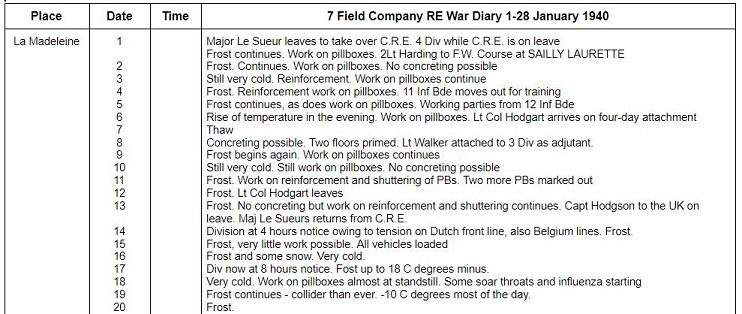

1940
01 Jan. The phoney war, ‘sitzkrieg’ continued. Work on the frontier was held up, heavy frosts hampered the concreting and serious drainage problems were experienced due to either spring water or damaged drainage when excavating some sites. Security was at a premium as the frontier was still open and many locals lived on one side and crossed daily to work on the other side.
Lt Curtis became OC 1 section as Lt Walker was posted to 3rd Division HQRE as adjutant. 2nd Lt V Harding was posted as a reinforcement and Lt Walmsley-White was attached from HQRE. CSM E Gilbert a veteran from WW1 became CSM. Daily temperatures fell to a minus 10 degrees centigrade and more. Driving was treacherous, a CDF of 3 section skidded past 2 trams and end up crashing into a café. The ground was hard enough to take heavy armour and ‘Fall Gelb’ (plan yellow) raised its head again, this being the German code for the invasion. The BEF was put on full alert. Meanwhile, a German officer flying near Belgium lost his way and landed in Belgium. He was caught in the act of trying to destroy some papers, which were proved to be the full plan of ‘Fall Gelb’. This in part caused Hitler to change the main armoured thrust from the Flanders plain to the Ardennes.

7 Field Company RE War Diary January 1940 typed as written
7 Field Company RE War Diary February 1940 typed as written
A BEF unit mixing concrete 1939-40
Pillbox shuttering with first lift concreting
7 Field Company RE War Diary March 1940 typed as written
01 Apr. As the weather improved work on the frontier was pushed ahead as quickly as possible. 1 section completed one of the first A/T pillboxes in a barn near Neuville. It was later reported as being of great interest to the German General Staff, and that both General Von Rundstedt and Goering inspected it.
7Apr. Lt Vaughan- Williams 246 Fd Coy RE was posted as 2/ic. In view of a fracas at a very high level about the work of the BEF, two summaries of the main tasks of work completed by the BEF and Shiny 7 are of interest.
BEF: 400 Pillboxes, 40 miles of revetted A/T ditch, 50 new airfields involving the laying of 50,000 tons of concrete. Store dumps to take 10 days supply between the Seine and the Somme.
7th Company RE: 100% 1 A/T, 3 Bren ; 75% 1 A/T, 1 Bren; 50% 3 Bren, double MG. Plus a number of sights excavated and bunkers prepared. Seven days supply had been built up in the dumps north of the Somme, with a tail of 500 miles to the main ports. Lord Gort reported shortages many times during the previous 8 months. In particular, there was no A/T ammunition for the RA in France. The only armoured division destined for the BEF, 1ST Armd Division was still in the UK.
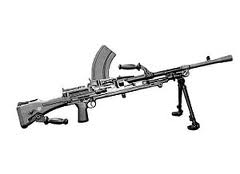
Bren Gun

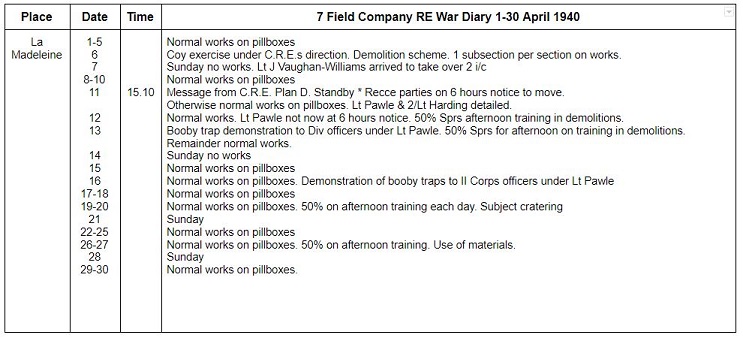
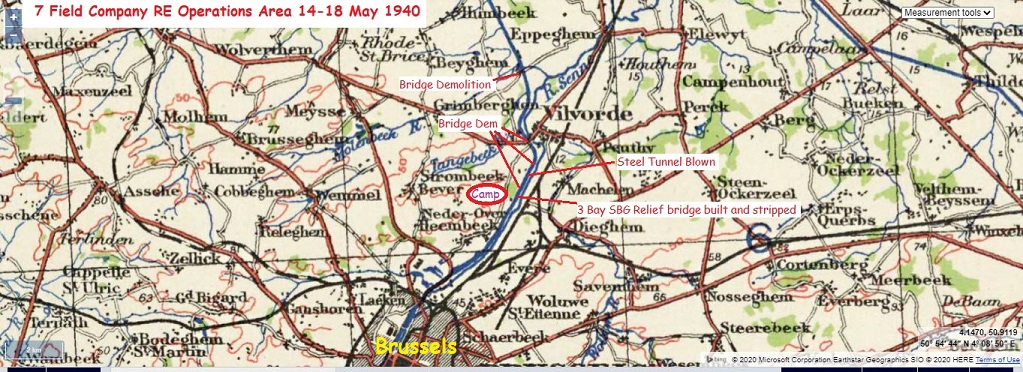
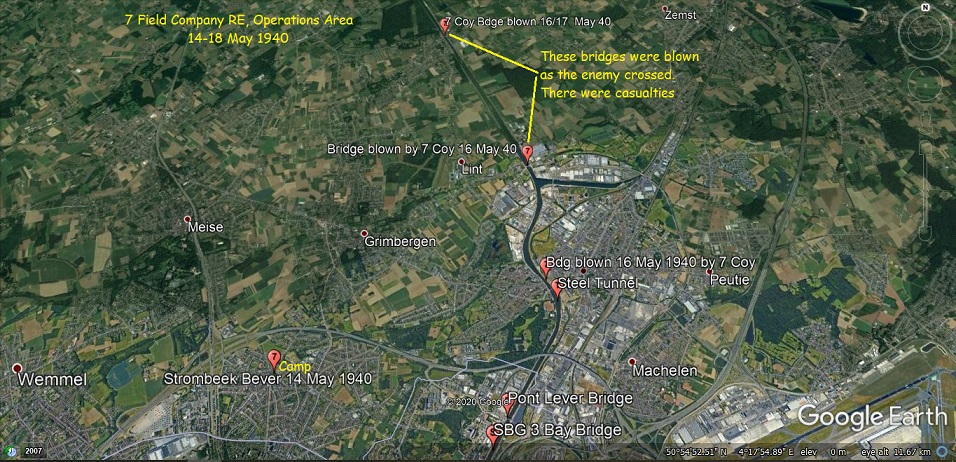
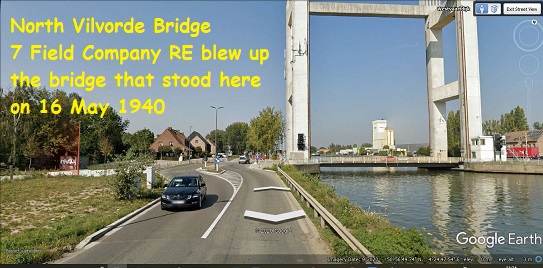
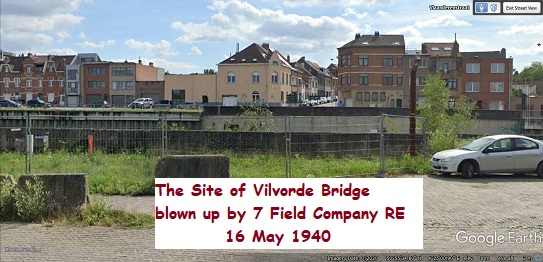
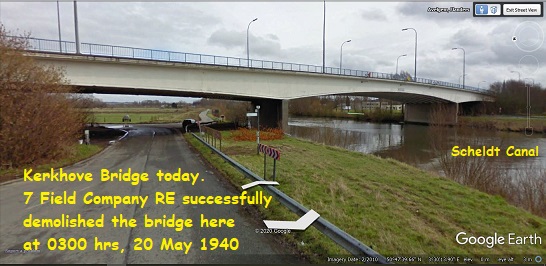
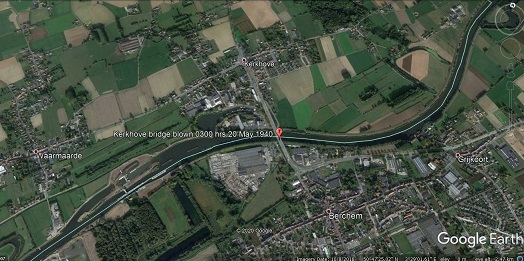
27 May Monday. As dawn broke the convoy dispersed around a field on a ridge at Marieburg. Vehicles spaced themselves out under the high hedgerows and the cooks prepared breakfast on the double as officers left to recce the river Lys Comines/Quesnoy facing south. It was essential to hold this position for the withdrawal of the division. The 5th Div (two Bdes the other Bde was sent to Norway) and the 143 Bde were in position on the Comines/Ypres disused canal. Sometime after breakfast, a Dornier ‘Flying Pencil’ suddenly flew very low over the ridge, as much to say we know you are there, which happened so quickly the ‘Brens’ could not be brought to bear. The sole survivor of an RASC convoy was in a field, their vehicles had been bombed, chased into fields and finished off. The recces along the Lys were completed when at 0900 hrs Capt Hodgeson HQRE met the OC to say that he, the OC would take command of the Division's Fd Coys, 7, 59 and 225 to halt an advance of the German 61 DIV, which had broken through the 143 Bde covering Comines. The enemy was making a direct line for Warneton bridge over the Lys. A bridge of vital importance to the Division and the BEF, as it was the main axis for the withdrawal to the coast. The 225th, nearest to Comines were ordered to hold for 2 hours until 1100 hrs. ‘59’ wereposted on the left of Warneton and the 7th covered Warneton. ‘225’ held their position an hour longer than ordered until 1200 hrs, and then almost surrounded withdrew to their allotted position on the left of ‘59’. 1 Section was in a reserve position in the village of Warneton and on its bridge. 2 Section were on the right of the Warneton-Comines road and 3 Section on the left of the road with one Sub Section pushed out about 200yds down the road, two lookouts from this Sub Section were posted on an embankment some way down the road. At intervals, shells came crashing down as the enemy gave direction to his advance on Warneton. The only visible sign of 61 DIV was an observation balloon, the all-seeing eye, watching positions being dug, then sending over stonks bringing telegraph wires down alongside the road around the forward Sub Section. Looking towards Comines from the OP to the right of the road near Comines, large houses stood well back from the road. The ground on the left was flat and devoid of cover. In the distance, a copse was visible with a farm beyond it. There was barely a cloud in the sky. It was warm, sunny and there was no sign of life. The local population had collected in large buildings keeping out of sight.
Two light tanks of the 13/18 Hussars arrived in support and a weak PL (9 ORs) of ‘A’ Coy 6 Black Watch with a Bren carrier. The CRE placed the RE under command of the Black Watch. An ‘O’ Group was held in the station at Warneton to co-ordinate a counter-attack, with the objective the Comines-Ypres canal which was dry and on the far bank a railway embankment ran parallel from Comines to Ypres, and a small stream the Kortekeer winded its way over the ‘7’ sector near Comines 3000yds from Warneton. The plan was that the ‘7’ and the Black Watch element would lead the advance at 1800hrs, ‘59’ would be echeloned 400yds back on the left of the Black Watch, and a further 400yds back on the left of ‘59’ the ‘225’. Section Sgts warned Sub Sections: Counterattack in an hour at 6 o’clock with one field gun in support. The question was, could this gun shoot down the observation balloon? A meal was had. Water bottles, weapons were checked. Pouches filled with ammunition and at least one bandoleer of ammunition slung over the shoulder of each sapper. A special party would take the ‘Boys’ A/T rifle and the ‘Bren’ into action. Grenades were not issued to RE Sections at that time. The only way of communication was by a runner. In 1914 the BEF fought over this same ground to halt an attack designed to seal their fate: they were successful, a good omen. The urgency of the situation heightened as in the meantime. 61 DIV had registered the bridge at Warneton with MGs indicating that a ground attack was imminent. Sprs F Daly and Peplow were on the scene manning a pillbox under a steel girder bridge with two French soldiers who laid on the ground refusing to look out once the firing started. Promptly at 1800 hrs feeling very exposed, Sub Sections left their trenches, moving towards the objective with fixed bayonets. The field gun had not done its stuff! The observation balloon still floated ominously north of and beyond Comines surveying the ground. The advance was at a steady walking pace. Sprs Lamb and Riley the Op team on the embankment followed the road to Comines out of sight of their subsection. They reached Comines leaving there about midnight not having seen anybody returning to their original OP position. The main body walked forward scanning the flat ground advancing a good mile and a half when contact was made. An MG began to fire at the leading Sub Section of 3 Section from a farm about 300yds beyond the copse seen from the original positions. The copse was growing around a pond. As the remainder of 3 Section reached the pond and copse they veered to the right to skirt it closing in on 1 Sub Section engaging the MG first standing, kneeling then final in the prone position. The Section was now bunched moving into and through the beaten zone of the MG/MGs with spurts of dust kicking up here and there. 1 Sub Section had concentrated their fire on a window of the farm silencing at least one of the MGs. There were about 100yds between the edge of the road and a railway embankment, which ran parallel to the Warneton-Comines Road. The only cover was a patch of nettles. The whole Section moved forward between bursts of fire. The enemy now made full use of his excellent observation bringing down a heavy stonk so accurately that one Spr mistook the smell of cordite for gas, and gave a gas alarm. The section was now pinned down, part of the Sub Section climbed the embankment taking their wounded (Lcpl F Rose and Spr W Stone) with them. The enemy decided to evacuate the farm showing the ‘white’ flag. 2/Lt Harding gave the order to ‘ceasefire’, which stopped. The enemy evacuated the farm, then at a prearranged signal went to ground opening fire with all their weapons. 2/Lt Harding, Cpl Trice, Lcpl Bonner and Sprs Black, Bothwick, Froude, Hoodless, Vollans, Whitwell were all killed. Spr Baker is reported as having shot a sniper out of a tree. The use of the ‘white’ flag by the Germans to gain an advantage is now well known, they considered it to be proper ‘ruse la Guerre’. Anything to gain an advantage on the battlefield went for them. CQMS Fryer HQ Section continued to support the attack with a Bren gun even though wounded in the ankle.
Towards dusk 1 Section went forward to occupy a large building near Comines on the right of the road. Spr Davinge carried a ‘Boys’ A/T rifle into action at all times. When he tried to use it, he found the bolt was damaged. By this time the two 13/18 Hussars tanks were on fire. Farms were burning, tracers were streaming in all directions, our own and enemy positions were intermingled so much so that the Germans could not use their artillery to full effect. As dusk fell the enemy advantage of perfect observation was lost. ‘59’ came up to the left of ‘7’ and the Black Watch to take their position walking through the smoke of burning buildings with fixed bayonets. Major Macdonald OC ‘59’ was mortally wounded. Major Gillispie although wounded, remained in action until ‘7’ was relieved. ‘225’ took up their position on the left ‘59’ but were not fired on. It was now a matter of holding and consolidating the position. Unknown to the RE and the Black Watch. Another attack was launched from Messines ridge at 2000 hrs by the 3rd Grenadier Guards & 2 N Staffs, and as the Guards came up to the last rise they could see the RE making their final advance with fixed bayonets silhouetted against burning buildings. This inspired the Guards and although they had many casualties, they came up to the canal line dealing with the enemy, some savage fighting took place. One or two of the Sappers fought on with them, Spr Rayner of 3 Section did not hear the order for the‘7’ to withdraw, he remained with the Grenadiers until they returned to England. Sprs F Daly and Parry (Tich, there were two Parrys) carried a wounded guardsman back to the RAP at Warneton. At midnight the ‘7’ holding positions here and there in pairs and small groups were ordered to withdraw. The Black Watch was taking over. The Bde commented: “A counter-attack restored the situation. The bridges on the waterline were vital to the battle”. The water line being the Lys bridges, with Warneton the most important.
Corps history gives a short account of the attack, it was probably unique in the Corps history as it was the first time that the whole Divisional RE had been used in a counter-attack. There is always a price to pay. Apart from those already mentioned, Spr/Dvr L Shepperd was killed at Dozinghem. The OC, CQMS Fryer, Lcpl F Rose and Sprs B Glass, Shaw, R Shepperd, W Stone and Townsend were wounded. As a result of this action, immediate awards were made on the beach at La Panne. The battle became known officially as ‘The battle of the Ypres-Comines Canal’.
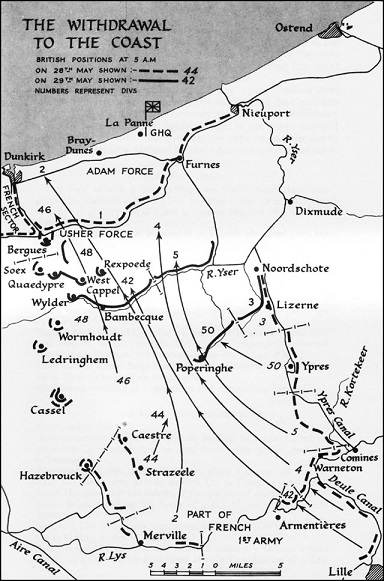
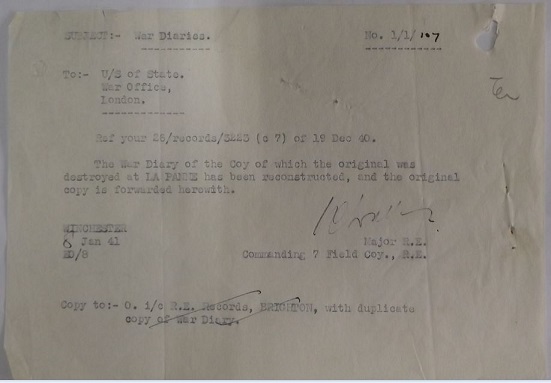


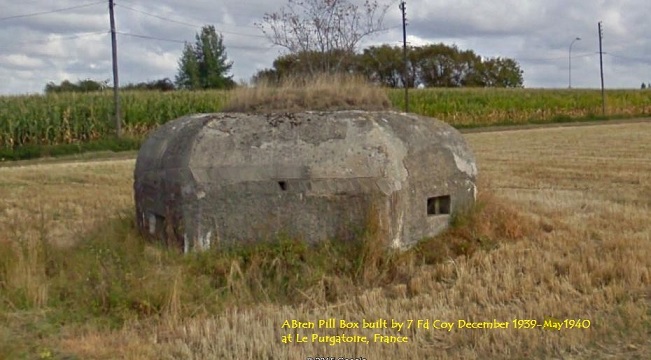
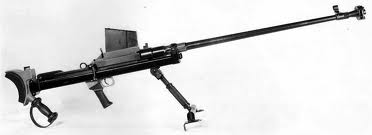
Boys anti-tank rifle. Used by the British Army early in the second world war
Fall Gelb 10 May 1940
The German assault had been carefully prepared. The first target was to be the left flank of the Maginot Line - the lightly defended frontier of France between the Ardennes and Dunkirk. The second target was to be the Channel ports, in particular, those ports from which the BEF might hope to escape. The Allies prepared to defend a succession of lines which followed, as far as possible, the line of natural anti-tank obstacles. The Belgium Army was to defend the Albert Canal from Antwerp to Maastricht, and the River Meuse from Maastricht to Liege. Behind this line of rivers, the French were to defend the river line from Antwerp to Mechelen. The B.E.F. was to hold the river Dyle from Mechelen to Louvain and the french to come up on the right to hold the line from Louvain through Gembloux to Namur. There is no natural tank obstacle between Louvain and Namur and this part of the line was known as the Gembloux gap. The right flank of the Belgian line south of Liege, and of the Anglo-French line at Namur, was comparatively lightly held, as the country was too difficult for a rapid thrust, and farther still to the south rise the Ardennes, said to be impassable to tanks. The B.E.F. began to move into Belgium from France as soon as the news of the attack was received. The 3rd Division reached the Dyle at Louvain that night. Since 4th Division was initially to be in II Corps reserve, zero hour for the Division’s advance was not until the night of May 13th.
4th Division moved into Belgium along two roughly parallel roads, route G, on the right ran through Tournai, Renaix and Ninove to Brussels. Route H, on the left ran through Audenarde and Alost to Vilvorde, a small town on the River Senne six miles north-east of the centre of Brussels.
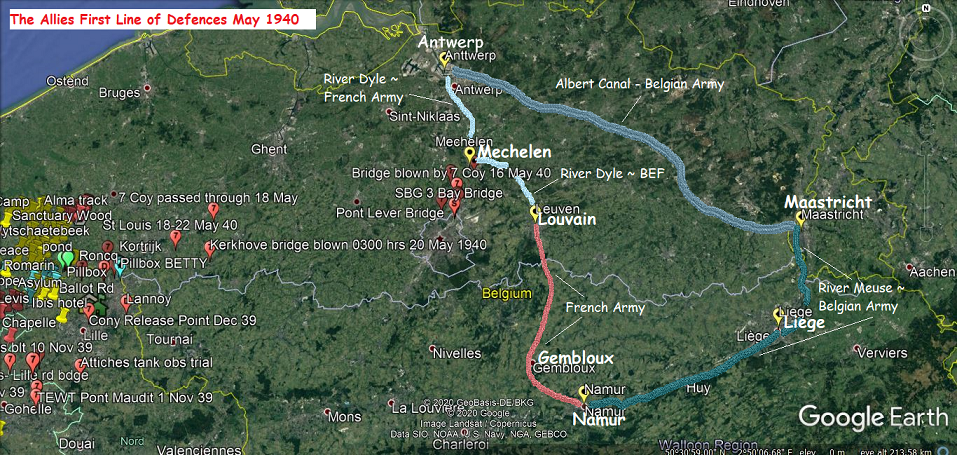
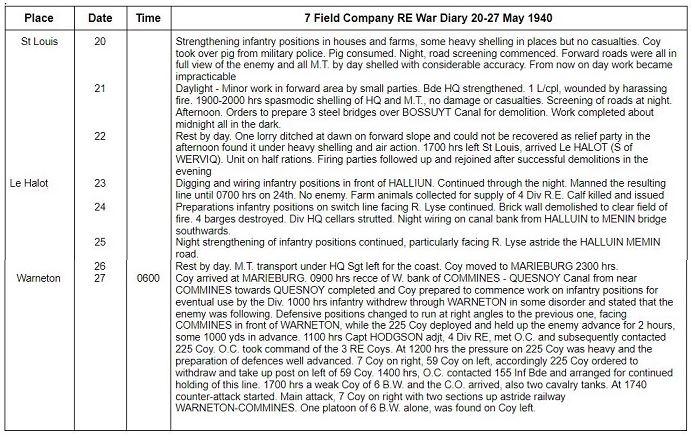
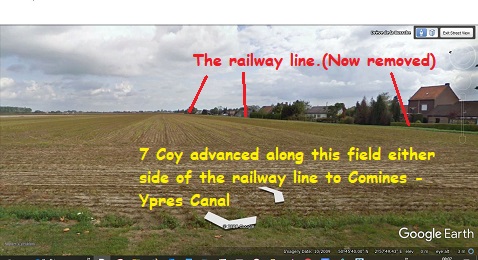
Viewed from Bas-Warneton, a village inbetween Warneton and Comines and 1,300 yards into the advance to Comines 27 May 1940
Some of the graves; Grave No 9 Spr Whitwell, No 10 2/Lt Harding,
No 11 Known onto God, No 12 Spr Froude, No 13 Spr Borthwick, No 14 L/Cpl Bonner No 15 Spr Haynes 59 Coy, No 16 Maj MacDonald OC 59 Coy. Not shewn No 17 Spr Hoodless, No 73 Spr Black.
16 15 14
13 12 11
10 9
The Ypres-Comines Battle memorial at Comines.
The three RE Field Companies are named on it together. 7, 59, 225.
Every year on the 27 May, there is a commemoration by the
local population of the battle.
Ypres-Comines Canal Battle Memorial Park information board
Right: Grave No 17 Spr Hoodless
The enemy was making a direct line for Warneton bridge. A bridge of vital importance
to the Division and the BEF, as it was the main axis for the withdrawal to the coast.
15 September 2015. 7 HQ & SP SQN RE members stand on the, once, railway line, on the 1940 battlefield their forebears fought.
At the top of the Ypres-Comines memorial
is listed the units that took part in the battle
Whilst 61 DIV was being pushed back, 3 Div on the right of the Division broke contact and made a night march close to, and across the rear of the battle area to take up defensive positions north of Ypres by first light the next morning; to hold back the advance elements of the 19, 30 and 216 German DIVS pressing forward to be first on to the crossings over the river Yser north of Ypres. King Leopold of Belgium sued for an armistice and a cease-fire to commence at midnight. The allied C-n-C General Weygand indicated that this came as a thunderclap. He knew from May 16th when the BEF had held on for another day on the Dyle that it was only a matter of time before the Belgians sued for peace. The Belgian army could do nothing to protect the BEF left flank except to blow every bridge over the Yser and to open the sea locks at Nieuport. These things they failed to do. They did make an unsuccessful attempt to lift the stranded 60 French DIV south of the Yser to Nieuport. In the event, the 60 French DIV were surrounded at Ostend. The Belgian surrender came into effect May 28. The terms of the surrender did not affect the British or French. The result of the Belgian surrender was that a thirty-mile gap was opened on the left of II Corps to Nieuport on the coast. It was now a race to fill the gap, and at the same time the Corps must hold back the German advance from Comines to Nieuport. The door was open on the coast if the German 256 DIV could cross the Yser at Nieuport. Where the sea locks were closed the beach-head could be rolled up. Once opened the sea locks took four days to operate. In 1914 the Germans suffered a disaster when 3’ of water engulfed a major attack. Hitler was well aware of the 1914 disaster and had no intention of seeing his precious armour caught in the same way on marshland.
28 May Tuesday. ‘7’ was relieved from 0100 - 0500 hrs to give time for all elements of the Company to return to their MT located just outside Warneton where 1 Section MT was waiting for them. On the canal line, the infantry was consolidating positions. The Germans were fighting back and the whole area was a mass of small arms fire. Before the Germans could mount a co-ordinated attack they would have to pull back their units to regroup and bring their artillery to bear, which could not be done as both sides were intermingled. It was with some difficulty that the Shiny 7 could withdraw. At 0600 hrs the acting OC Captain Vaughan-Williams led the Shiny 7 to Marienburg where orders were received to proceed to a ‘Report Centre’ at Hondscoot. Optimistically ‘7’ were routed through Ypres, which was under attack. The weather was overcast building to rain, hampering the Luftwaffe. ‘7’ escaped their attention pulling into a large wooded area at Eikhoek at 1400 hrs.
During the journey, they had to endure packed roads. At one point a French Division cut across their path causing delays. In this location, there was plenty of cover for transport. Sections were in large barns with plenty of straw to bed down. A party of three were left behind in last night’s battle. They decided to march south along the Lys towards the frontier and came across another sapper unit preparing to blow a bridge from the Warneton bank. They met up with the 4 DIV GOC who asked them a whole string of questions about the attack receiving a number of honest answers and requests for ‘Tommy Guns’ said that: “Additional weapons are on the way” and went on to say that “the ‘7’ had done some outstanding jobs in Belgium, but last night was brilliant”. The party got a lift with the ‘59’ to the woods at Eikhoek and were finally reunited with the Company, though they had just missed out on the evening meal and had to make do with hardtack and tea. Then the Company were ordered to Nieuport to blow bridges under command of 12 Bde, ordered to defend the area.
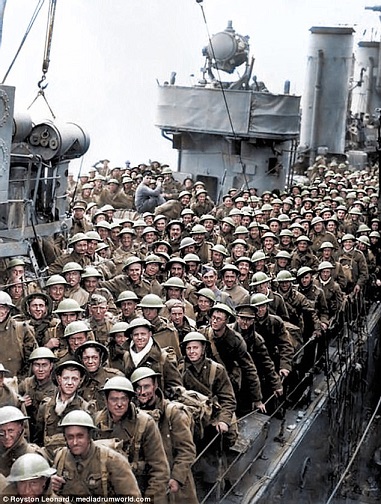
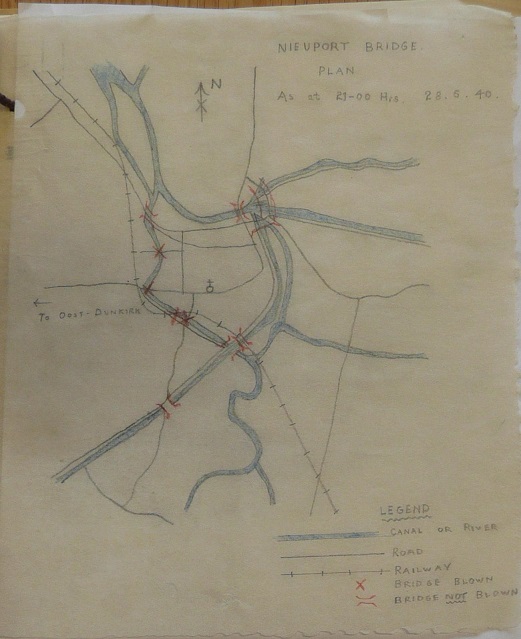
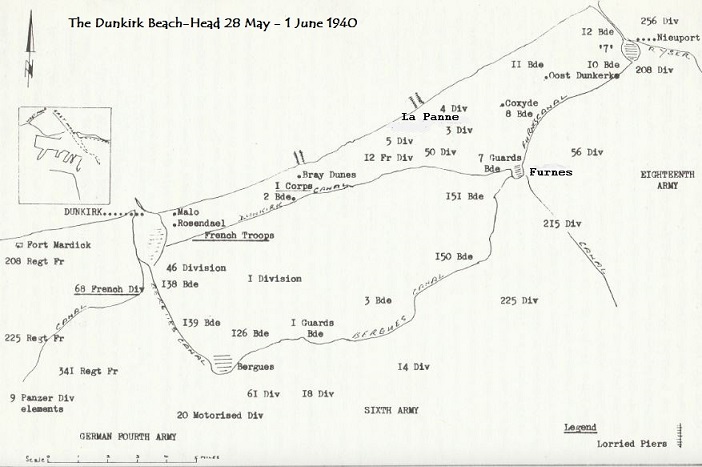
Nieuport bridge demolitions Sketch map taken from 13 Survey Coy RE, war diary
Below: 7 Field Company RE at the for the Ypres-Comines Canal May 1940
A note in the war diary declaring that the original 7 Coy war diary for May 1940 was destroyed at La Panne and reconstructed
7 Field Company war diary typed out as originaly written
Dorniers flying over France. A familiar site for the BEF 1940
One of two lorry Piers built at La Panne. A party from 7 Field Company took part in their construction 31 May 1940.
Above: One of the two lorry piers at La Panne
British troops being evacuated
Bogner November 1940
Pillbox at Pagham built by 7 Coy or their contractors July-August 1940
War Diary typed out as per how originally written
11 November. 3 DIV joined V Corps in place of 50 DIV. The 7th concentrated bridging using the SBG and FBE interrupted only by Divisional exercises set by the Corps Commander. The Divisional GOC inspected the Camp at Crawley Court and by November the 26th the Shiny 7th were installed there. The Nissen huts were finished. Showers fitted in a stable with the Company office on the first floor. A long low building was made into a cookhouse and dining room. It was big enough for the whole Company and was often used by the OC for briefings.
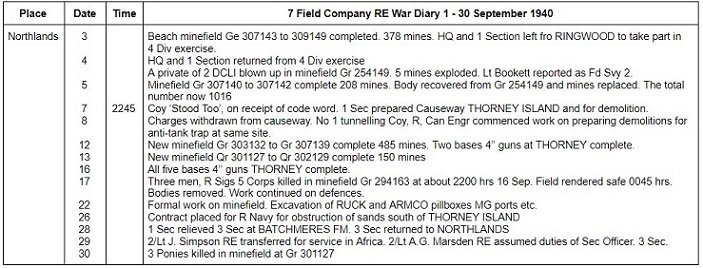
02 December. Lt-General Alexander took over Southern Command , and Lt-General Auchinleck was promoted to be C in C India. Lt R L Clarke was posted as OC 3 Section. The 7th now had their first taste of desert warfare in the form of Exercise No1 on Salisbury Plain. Place names were altered to Arabic names. ‘Monty’ couldn’t simulate the weather though. Vehicles got bogged down. All the 8 cwt PUs boiled up and motorcycles sank in the mud. The conditions did not prevent the 7th building a Class 24’, 64’ SBG bridge during the hours of darkness and erecting water points. After the Exercise ‘Monty’ held a conference of all officers of the Division at the Odeon cinema in Winchester. A number of those present have described this conference the forerunner of many more, which became part of ‘Monty’ lore. The stage was clear except for a huge drawing of the Corps sign, a Viking ship as a back cloth, when the trim figure of ‘Monty’ appeared dressed in battledress and said to a packed audience: “There will be no smoking, there will be three minutes for coughing, there will be no coughing during my comments”. Then without notes he proceeded to go through the whole exercise, enumerating the lessons to be learned etc. He insisted that the staff of all HQs would complete a seven mile cross-country run each week. He much preferred that anyone who might collapse because of the run should do so and not in the middle of a battle. Distractions such as families living in the area were forbidden. Southampton was one of the targets to be bombed by the enemy. Parachute mines were dropped at random in built up areas causing large scale damage. A party from the 7th went to 30 Fd Regt RA billets hit by a raid to repair main supplies and buildings.
15 December. The 7th moved to a bridge camp at Howbery Manor, Wallingford to work with pontoons, wet bridging on the Thames, returning to Crawley a week later. Christmas day was celebrated in the traditional manner when the officers served the Christmas Dinner. The year ended quietly.
